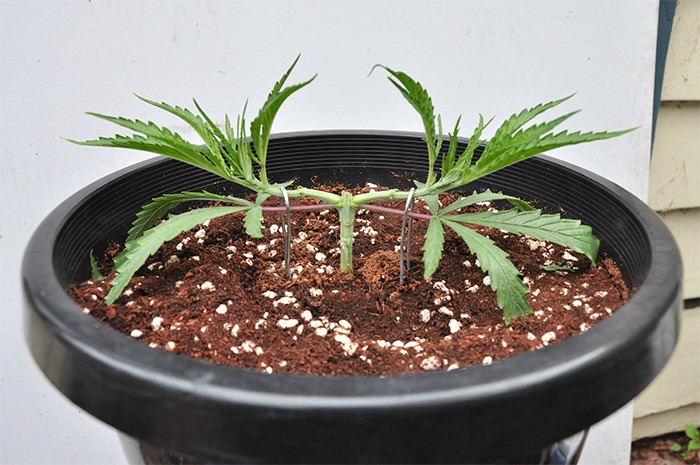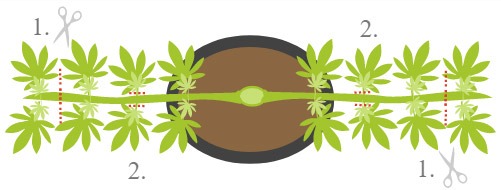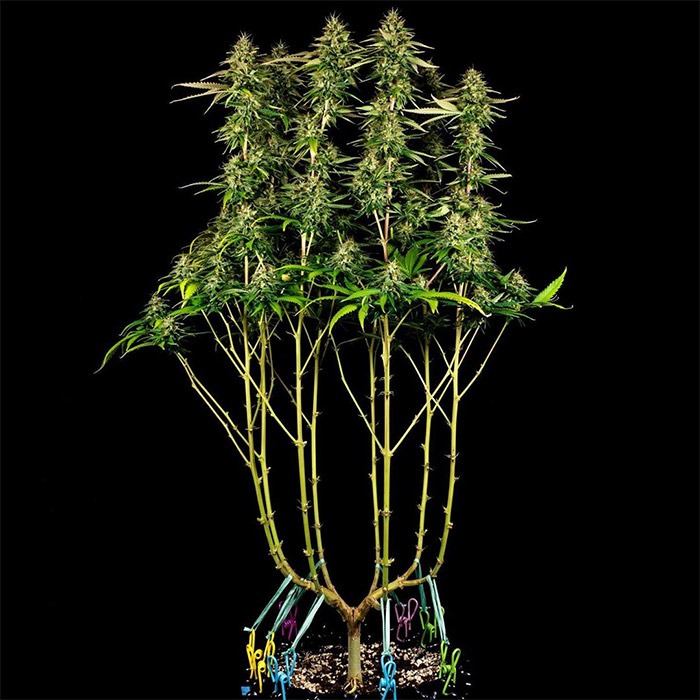Main-Lining: The right growing technique for your cannabis cultivation?
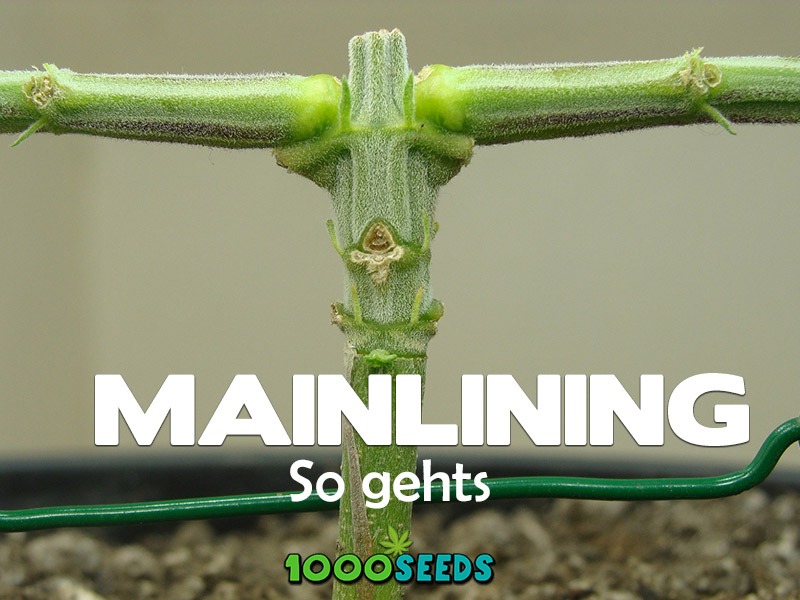
Mainlining is a relatively new and interesting cultivation method. We want to show you what mainlining is, what you should consider and where the advantages and disadvantages lie. Who knows, maybe main-lining won't just be an alternative for your next grow, but will become your favourite cultivation technique in the future. In the cannabis scene, main-lining is already being discussed and used with enthusiasm all over the world.
What is Main-Lining?
Main-lining is a cannabis cultivation technique that offers several advantages. The aim is to get as much yield as possible from small plants. Ideally, this increases not only the quantity but also the quality of the yields. Main-lining is sometimes also referred to as manifesting or fluxing.
The technique behind it requires a little practice and background knowledge. This is because main-lining requires a lot of manipulation and shaping of the plant during the growth phase. The goal is "multiplicity". Hence the alternative name: Manifolding. This stands for multiplicity or diversity. The aim is to grow as many flowers as possible from a single nody. This gives rise to the peculiar shape, which can indeed be compared to that of a houseplant.
Each main shoot receives the same amount of water, light and nutrients if you follow the step-by-step instructions. This results in even growth and more yield, which is also easy to harvest.
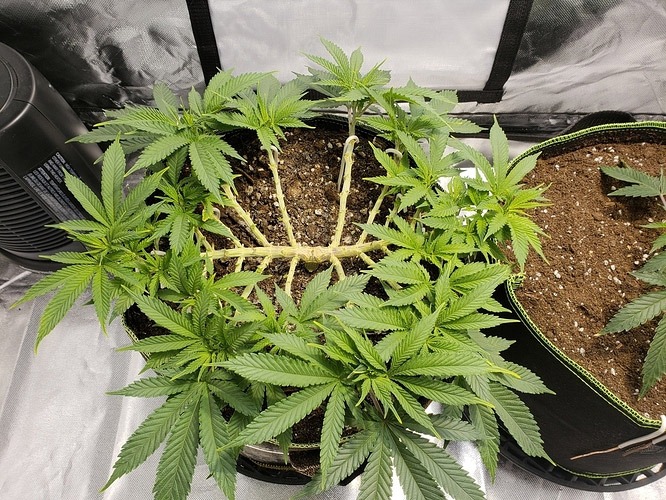
Mainlining manipulates the natural growth of the plant. This normally forms a single main shoot/headbud, which is favoured and receives the most nutrients and light. The technical term for this is apical dominance.
If you grow your cannabis plant in a controlled environment, you can instead make sure that all the shoots are the same height and therefore the same proximity to the light. This will ensure an even supply of light and water.
For a first try, you can try four main shoots. But ultimately, with this technique, it is also possible to get 8, 16 or 32 colas. Note, however, that you will probably need more space - for indoor growing, 8 colas are very good.
To achieve the desired result, main-lining requires the combination of LST (low stress training) and topping. The exact instructions will follow shortly. First, let's look at the advantages and disadvantages of main-lining. So that you can decide whether you have found your new favourite technique.
The advantages of main-lining
Whether main-lining is a good alternative to SOG (Sea Of Green) and SCROG (Screen Of Green) is often debated and is probably a matter of taste. However, fans of the technique swear by the simplicity and advantages that main-lining offers them.
For one thing, you need less equipment. Main lining works without ScrOG netting or other gimmicks. Air circulation is already encouraged by the special growth. So all you really need are your cannabis seeds, your scissors or razor blade and string or wire.
Especially for private breeders, the question of space always plays a role. With main-lining, you need less space. Many main-lining experts also report on the simplicity of harvesting.
If you use the technique correctly, you will get bigger flowers. This already sounds very good, but there is another advantage: after the demanding first phase, you can sit back and relax. Once you have trained your plant, it will do the rest for you and develop an even flowering.
Last but not least, many main-lining enthusiasts swear by this technique as it is perfect for avoiding popcorn buds. The small and low-yielding flowers are prevented by regular removal of anything sprouting below the main strands, as well as the low stress level after the early vegetation phase.
The disadvantages of main-lining
As already mentioned, main-lining requires a lot of attention and precision at the beginning. Whether your plant succeeds is determined in the early stages of growth. Another possible disadvantage is that you have to allow more time until harvesting. Especially for private growers, this should not be a problem, considering the advantages mentioned above.
All in all, it's a question of prerequisites and your preference. Because there are no real disadvantages to main-lining, it is simply another technique that yields more for certain growers and is an alternative to the classics SOG and SCROG.
Information first, Growing second
For experienced cannabis growers, the following explanations may be cold coffee, but main-lining can also be suitable for beginners. Hence a short crash course that will be extremely important for the step by step guide that follows.
The vegetation phase:
In the growth phase or vegetation phase of the cannabis plant, the main work takes place. It begins with the formation of the first leaves. Before that, the plant is still very sensitive and only after the first leaves have formed should repotting begin. After the plant has developed a decent root system, growth will accelerate and it will become more resistant.
Low Stress Training:
In LST (Low Stress Training), the cannabis plant is shaped. Strands are tied with the help of ribbons, cords or cables, and thus the growth is driven according to one's own imagination. This technique is not without risk, as the aim is always to bend, but breakage of branches should be avoided. Therefore, most growers use this technique early in the vegetation phase, when the branches are still soft and bendable.
What is Topping:
If LST stands for low stress, then topping is a method that causes a lot of stress. The upper parts of the plant are cut off to encourage growth in width. This also takes place in the growing phase. This grows more flowers, which can also produce more yields. However, this can lead to a slowing down of growth (more rest needed) and a higher susceptibility to diseases. Normally, a healthy cannabis plant does well with topping.
How much space do you need for main lining?
The more flowers you want to have in the main lining, the more space you need. For eight flowers you should plan at least 60 cm². If you want to try it with 16 flowers, you should bring 1 m² and with 32 flowers 2 m².
Step-by-Step to Main-Lining
Now that you are familiar with the most important information about main-lining, its advantages, disadvantages and potential, you will want to know how to grow your first plant using the main-lining technique. The following 8 steps will explain it to you.
Step 1: You need 5 nodules
In the first step, you have to wait until your plant has developed 4 to 6 nodes. Here you should also make sure that your cannabis plant is healthy, so that you can carry out the later steps in the best possible way. But always make sure you don't wait too long before moving on to the second step. If your plant is already flowering, you are too late. The founder of the main-lining technique (Nugbuckets) swears by 5 to 6 nodes for optimal and quick success of the technique. If you start earlier, you risk the plant not being hardy enough.
Step 2: The first topping
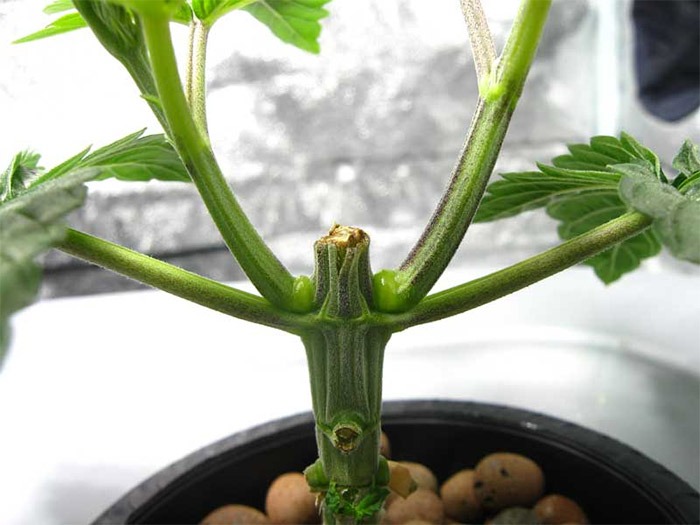
Once you have waited until 4 to 6 nodes have formed, you can start topping. To do this, cut above the third node. Two growth strands remain. Now remove everything (leaves and shoots) except for the third node and the two strands that will form your starting point.
Now the plant will concentrate all its energy on this third node. Tie the two growth strands down at a 90 degree angle if possible - this is the low stress training mentioned above. Here, too, you have to consider the health of the plant: If the strands are still too weak, give them a few days to grow. The more ideal the conditions are for your growing, the higher the probability that you can start quickly.
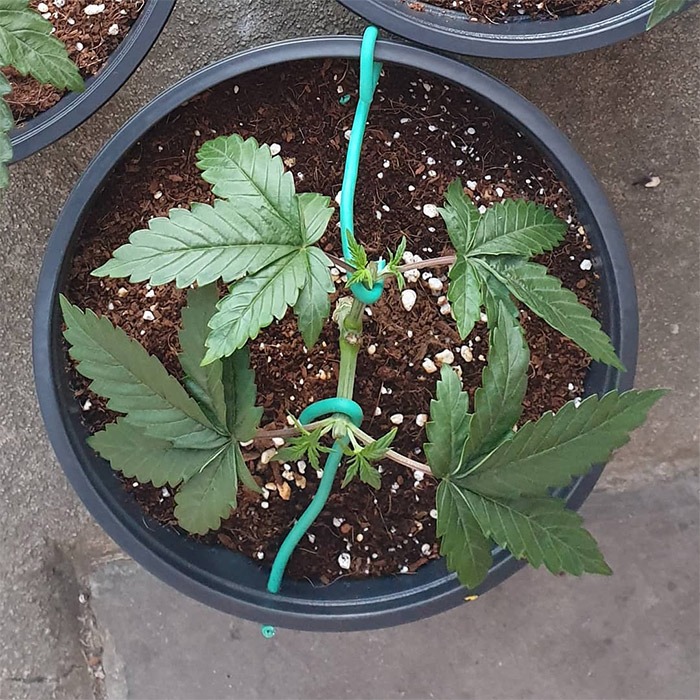
Step 3: Growth and 2nd topping
Your plant will be happy about step 3, as it can first grow again and thus recover. The two main shoots grow and form nodes.
As soon as they have emerged sufficiently, select a nodule to top in the same place on both sides, if possible. Again, remove everything underneath to allow air circulation and to give the plant the signal to concentrate all its energy on the remaining shoots.
Now repeat the low stress training, tying the new shoots down as soon as they are strong enough.
Step 4: The number of colas
Theoretically, you could stop now. You would have four colas growing symmetrically. However, most growers use this technique to achieve even more colas.
To get more colas, repeat the previous steps. The aim is to always top the shoots that are at the same height. This allows for even growth. With this you can double your colas again, to 8 colas or again to 16 or even 32.
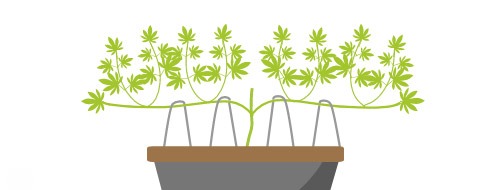
How big your plant will grow depends on your requirements and wishes. Indoors, most growers stop at 16 colas at the latest, but more likely at 8. For you, this means applying the topping 3 times.
Step 5: The right shape
Depending on what your growing environment looks like or what you want to achieve, you can now start shaping the plants. Some growers have limited space and work with a ScrOG net, others want a more attractive shape and work with cables and wire loops.
Step 6: Remove cords
When the shoots are strong and your desired shape has been achieved, you can remove all the soil attachments from the early phase. The main work is done, your plant will now do the rest and it cannot use the strings and wires for that.
Step 7: Take care of your plant, it will do the rest
Now you can care for your plant according to your own ideas. Light, fertilisation and co. are the order of the day in this step, so you simply create the best conditions for your little symmetrical plant.
Step 8: Harvest at last
The harvest is about to begin. If you have done all the steps carefully, you should now be able to enjoy the advantages of main-lining: a rich yield that is also easy to harvest. If you also pay attention to the external values, you will be happy about the beautiful shape of the cannabis plant.
For those who are not afraid to invest some energy and work very thoroughly at the beginning of the cultivation, main-lining can be an excellent cultivation method. As with all methods, it is advisable to take extra care when topping to ensure that the plant gets enough rest and is protected from pathogens. With LST, it's better to wait a day longer than not enough to prevent breakage.
Apart from the increased attention required, especially at the beginning, there are no really big disadvantages to main-lining. The advantages clearly dominate here. This cultivation method will only fail if you don't try it ;).






